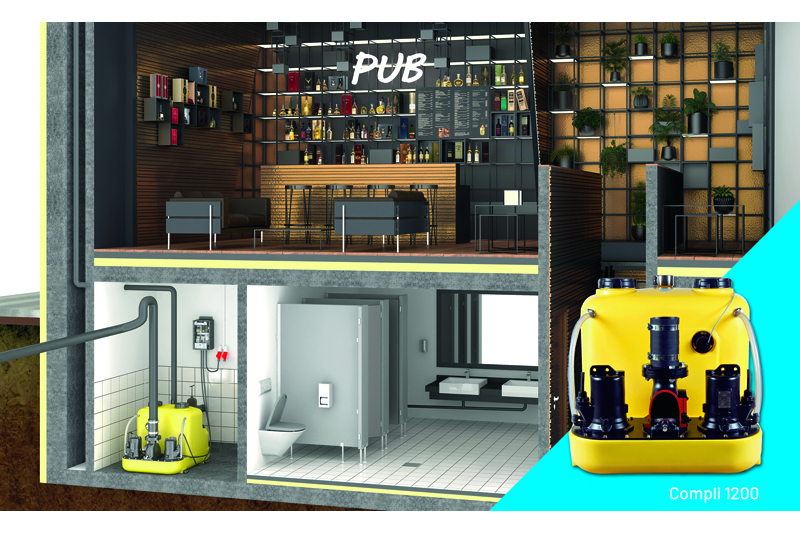
Jung Pumpen details the lifting solutions it can provide plumbers with when faced with challenges on light commercial projects.
When are lifting units used?
Lifting units are used when the gradient is not sufficient to dispose of the wastewater in the existing wastewater pipe. They are also needed if the wastewater pipe is far away from the point where the wastewater is produced, or to bridge long conveying distances.
Wastewater that accumulates below the backwater level (below the top of the road), such as in cellars or other basements, is pumped into the public sewer via lifting units. If the systems are correctly installed via a backwater loop, they also provide backwater protection, meaning that water that accumulates when the public sewer becomes blocked or after heavy rainfall cannot be pushed back into the building.
This is where physics comes into play, because if the backflow loop is above the height of the top of the road, the water in the pipe cannot rise above this height and therefore cannot flow back. However, drainage during backwater is still possible as the lifting unit pushes the water out. This is the great advantage over backwater valves, where drainage is not possible during such situations.
Depending on the quantity and type of wastewater, different systems may be appropriate.
Disposal of sewage containing faeces
Sewage lifting units are necessary if sewage from public sanitary facilities is produced in the basement. The wastewater flows into the tank and is pumped from there into the public sewer. In public buildings, it is important and also mandatory that the wastewater disposal system functions reliably. To ensure this, a duplex system should always be installed so that if one pump fails, the other takes over. Jung Pumpen has a variety of suitable solutions, depending on the amount of wastewater produced.
Disposal of wastewater (without faeces)
If wastewater accumulates, such as in tea kitchens, from coffee machines or from washbasins, in the basement and therefore cannot run off in a free gradient, then small lifting units provide the ideal solution. Compact systems can be easily accommodated in base units or pre-walls due to their small size. Once again, different pumps are used depending on the amount of wastewater produced.
Disposal of hot water
These systems have to withstand high temperatures and are therefore made of heat-resistant materials. This applies to both the tank and the pump. Despite high water temperatures, the plastic container must not deform or leak, while for submersible pump options, the casing as well as the outlet pipe must be designed to withstand hot water.
Plug-and-play systems are complete systems that require relatively little installation effort and are therefore designed to be easy to fit. As explained here, it is important to select the right lifting unit for the respective application. The decisive factor is which medium – condensate, hot water, water containing faeces or pure wastewater – is to be pumped, in which quantity, over which distance.
Quality is ultimately decisive in all applications, because pump failures are expensive in the commercial sector. For installers, the more reliable and trouble-free the system, the less chance there is of potential callbacks and downtime for customers.












